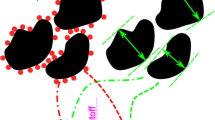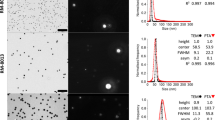Abstract
In the EU regulation, a material containing particles is considered as nano if, for 50 % or more of the particles in the number size distribution, one or more external dimensions is in the size range 1–100 nm. Due to the difficulty to measure in a reliable way the number particle size distribution, it is suggested to use the volume-specific surface area (VSSA) >60 m2/cm3 as simple screening criterion to identify nanomaterials. This threshold corresponds to monodispersed spherical particles with a size of 100 nm. In this paper, a theoretical study is carried out to identify the effect of the particle shape, polydispersity, agglomeration and aggregation on the VSSA threshold. It appears that the VSSA approach is overprotective because a lot of samples are identified as nanomaterials even if less than 50 % of the particles have a size lower than 100 nm, this 50 % in number criterion being the main identification criterion in the EU definition. Even if the VSSA is leading to many false positive results, it can be used to identify non-nanomaterials as soon as its value is lower than the threshold at the condition to take into account the shape of the particles and their external surface area. This conclusion is true for monomodal distributions of particles but is subject to some restrictions for bimodal distributions.










Similar content being viewed by others
References
Brunauer S, Emmett PH, Teller E (1938) Adsorption of gases in multimolecular layers. J Am Chem Soc 60:309–319
Guillet A Personal communication. Institut de statistique, UCL, Belgium
Kreyling WG, Semmler-Behnke M, Chaudry Q (2010) A complementary definition of nanomaterial. Nanotoday 5:165–168
Kumar V (2011) Simulation and modeling of unequal sized particles sintering. Dissertation, The University of Utah. http://content.lib.utah.edu/utils/getfile/collection/etd3/id/273/filename/611.pdf. Accessed 10 May 2011
Lecloux AJ (1981) Texture of catalysts. In: Anderson JR, Boudart M (eds) Catalysis: science and technology, review paper, vol 2. Springer, Berlin, pp 171–230
Lecloux AJ et al (1988) Study of the texture of monodisperse silica sphere samples in the nanometer size range. Colloids Surf 19:359–374
Linsinger T, Roebben G, Gilliland D, Calzolai L, Rossi F, Gibson N, Klein C (2012) Requirements on measurements for the implementation of the European Commission definition of the term “nanomaterial”. Reference report of the Joint Research Centre of the European Commission EUR 25404
Merkus HG (2009) Particle size measurements: fundamentals, practice, quality. Springer, Netherlands. p 15. ISBN 978-1-4020-9016-5
Olevski EA (2013) Sintering theory, brief introduction. San Diego State University, California, presentation. http://www.mawi.tu-darmstadt.de/media/fast/vortrge_2/0305_Olevsky_-_Theory_of_sintering.pdf. Accessed 26 Mar 2011
Parhami F, McMeeking RM, Cocks ACF, Suo Z (1999) A model for the sintering and coarsening of rows of spherical particles. Mech Mater 31:43–61
Park EJ (2007) Solid state sintering fundamentals presentation. http://fr.slideshare.net/support.xhht/solid-state-sintering-fundamentals-242041. Accessed 26 Jan 2008
Roebben G, Rauscher H (eds) (2014) Towards a review of the EC recommendation for a definition of the term “nanomaterial” Part 2: assessment of collected information concerning the experience with the definition. JRC report 91377. doi:10.2787/97286
SCENIHR scientific basis for the definition of the term “nanomaterial”. The SCENIHR approved this opinion by written procedure on 8 December 2010. http://ec.europa.eu/health/scientific_committees/emerging/docs/scenihr_o_032.pdf. Accessed 8 Dec 2010
Acknowledgments
The research leading to these results has been supported by the European Union Seventh Framework Programme (FP7/2007–2013) under the project NANoREG (a common European approach to the regulatory testing of nanomaterials, Grant Agreement 310584). The author would like to thank Tom van Teunenbroek, Aart Dijkzeul and Keld Alstrup Jensen for their encouragements and their interest. This publication reflects only the author’s views and the community is not liable for any use that may be made of the information contained therein.
Author information
Authors and Affiliations
Corresponding author
Rights and permissions
About this article
Cite this article
Lecloux, A.J. Discussion about the use of the volume-specific surface area (VSSA) as criteria to identify nanomaterials according to the EU definition. J Nanopart Res 17, 447 (2015). https://doi.org/10.1007/s11051-015-3239-3
Received:
Accepted:
Published:
DOI: https://doi.org/10.1007/s11051-015-3239-3




